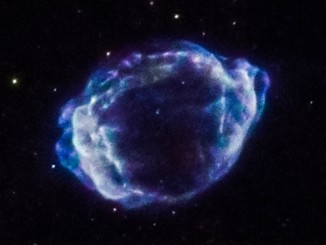
VLA



Astronomers identify a young heavyweight star in the Milky Way
Researchers have identified a young star, located almost 11,000 light-years away, which could help us understand how the most massive stars in the universe are formed. This star, already more than 30 times the mass of our Sun, is still in the process of gathering material from its parent molecular cloud, and may be even more massive when it finally reaches adulthood.

Chandra X-ray Observatory finds evidence for violent stellar merger
Gamma-ray bursts, or GRBs, are some of the most violent and energetic events in the universe. Although these events are the most luminous explosions astronomers can observe, a new study using NASA’s Chandra X-ray Observatory, NASA’s Swift satellite and other Earth-based telescopes suggests that scientists may be missing a majority of these powerful cosmic detonations.

‘Frankenstein’ galaxy UGC 1382 surprises astronomers
About 250 million light-years away, there’s a neighbourhood of our universe that astronomers had considered quiet and unremarkable. But now, scientists have uncovered an enormous, bizarre galaxy possibly formed from the parts of other galaxies. Some 718,000 light-years across, UGC 1382 is more than seven times wider than the Milky Way.

VLA radio map reveals what lies deep below Jupiter’s visible clouds
Observations with the National Science Foundation’s Very Large Array (VLA) have given astronomers an unprecedented look into the atmosphere of Jupiter. The scientists used the VLA to study the dynamics of Jupiter’s atmosphere from the visible cloud surfaces down to about 60 miles (100 kilometres) below the clouds.

Chandra captures expanding debris from Tycho’s supernova remnant
Astronomers have observed the debris field from the supernova of 1572, now known as Tycho’s supernova remnant, with NASA’s Chandra X-ray Observatory and the NSF’s Karl G. Jansky Very Large Array (VLA). By combining the X-ray data with some 30 years of observations in radio waves, astronomers have also produced a movie showing the expansion from the explosion is still continuing 444 years later.

Fast radio burst “afterglow” was actually a flickering black hole
Fast radio bursts (or FRBs) are brief yet powerful spurts of radio energy lasting only a few milliseconds. They were first identified in 2007 and their source has remained a mystery. New research shows that the radio emission believed to be an afterglow from FRB 150418 actually originated from a distant galaxy’s core and was unassociated with the FRB.

Trigger for Milky Way’s youngest supernova identified
Astronomers have used data from NASA’s Chandra X-ray Observatory and the VLA to determine the likely trigger for the most recent supernova in the Milky Way. They applied a new technique that could have implications for understanding other Type Ia supernovae, a class of stellar explosions that scientists use to determine the expansion rate of the universe.

Earth-space telescope observations of quasar 3C 273’s hot heart
Astronomers using an orbiting radio telescope in conjunction with four ground-based radio telescopes have achieved the highest resolution, or ability to discern fine detail, of any astronomical observation ever made. The researchers were surprised when their Earth-space system revealed a core temperature hotter than 10 trillion degrees for quasar 3C 273.
